The Gresley all-steel BG
The all-steel 61'6" bogie van to D.45 was built for the ECML in 1927-28 and as the photographs show, became a familiar sight there, eventually further afield as it was cascaded into lesser services, until c1960 when corrosion of the steel body took hold. A monocoque design, it had no trussing, no beading (but a prominent seam along the waist), and a steel roof built like a boiler. It was also two tons heavier. The LMS tried the same approach for its "standard" 50' BG. Somehow both types tend to escape the modeller's eye!
In this section I'm going to cover the prototype and show how they served in ECJS and GN-Section traffic in LNER, ER and even LMR days. Construction of two models, in LNER and BR finish will be in the Modelling section (see link below). The LNER one already runs on the rear of the northbound "Flying Scotsman" on Cliff Parsons' The Gresley Beat and it's pleasing to find that some people do actually recognise it!

The Diagram for D.45 showing what Cammell Laird produced in 1927-28. Fox 8ft bogies were the norm at the time and there are no known examples of anything else having fitted over the years.
There isn't a modellers' drawing but this and prototype photographs will take you a long way (see link at the bottom for the model I made). It's interesting to ponder that I now have 20-odd pictures of this BG in service, more than any other type; can't see one coming from Hornby, though! :) Author's collection.
Click on the image for an enlargement

As the official picture (author's collection) shows, the underframe had an airy look to it with the battery boxes suspended from the needle beams and the usual supporting strap under the middle. Fox 8ft bogies were fitted. The solebar had a full length footstep as was normal at the time. On the body, the steel panelling employed long sheets that were welded along the waist with a narrow bead over it, through which were mounted the long horizontal handrails - hence, depending on the light, relatively deep shadows there. The painted teak finish and shaded lining was done so well that from many angles, the difference was hard to spot. Indeed, a well-known picture with a D.45 van behind an A4 has often been captioned as a "teak-panelled" vehicle (see below)!
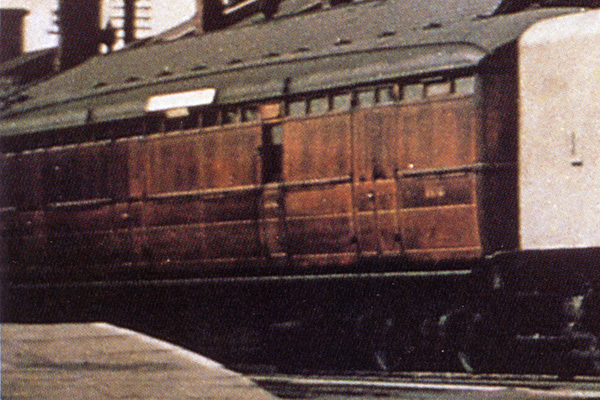
A steel BG was used with the "Flying Scotsman" from the outset, and even in BR days. This is a clip from a 1937 picture with Silver Fox in charge showing how well the teak finish was painted. The vertical lining appears to have been omitted.
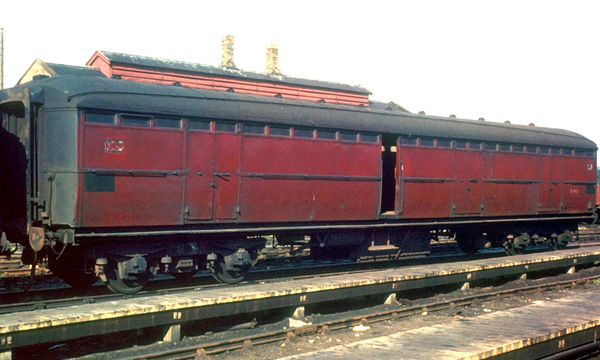
A fine picture of E191E at an unknown location in early BR crimson livery. The handrails along the waist are prominent, and the Fox bogies that were standard on LNER bogie vans until the early '30s. An interesting point is that the original GNR-style buffers have been replaced by the later, clipped-top type.
- Click on the image for a larger view.
In service
When built in 1927 these top-flight BGs were paired with the principal expresses on the ECML, including the "Flying Scotsman" until that train received an all-new formation in 1938. They were a very common sight on the ECML. They also served as through vans in the LNER's parcels traffic. The pictures are in chronological order.
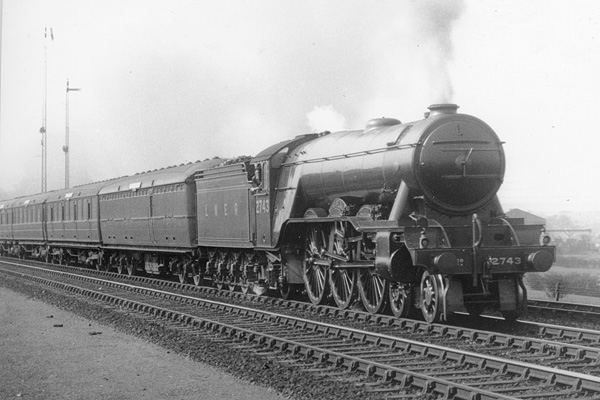
An undated picture with 2743 Felstead in charge, possibly from 1927, with what appears to be a recently built all-steel van behind the tender. This may be the final season before non-stop running of the "Flying Scotsman" began but sufficient of the stock isn't visible to be sure.

2569 Gladiateur near Potters Bar with an express. The picture has been over-written in white ink as the "Up Junior Scotsman" but to my eye it's high summer and the formation is nowhere near that train's. While I investigate further, it's another fine view of an all-steel BG in ECML service.
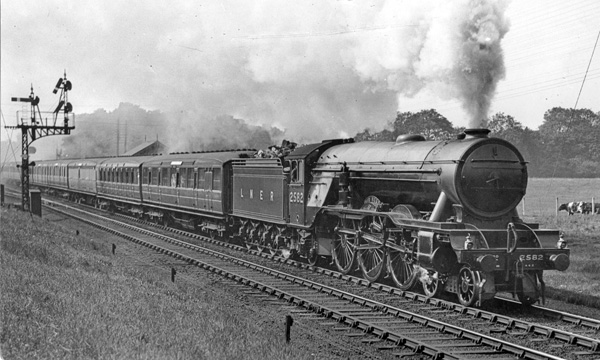
A stunning (and rare) picture from 1930 of A1 No 2582 Sir Hugo lifting the Down "Junior Scotsman" out of King's Cross. The leading carriage (1st/3rd locker) was for Perth and it's been strengthened by a 3rd without destination boards. Behind was the Glasgow portion which, at the time, contained a BG at the north end, as seen here, and for which an EC fleet D.45 was provided. It's carrying destination boards as usual. Photo: Author's collection.
Click on the image for an enlargement

An undated view from c1930 shows the "Queen of Scots" on a day when a BG had to be deployed and it's an ECJS Gresley all-steel one. D49 No 2754 Rutlandshire was in charge. Photo: Author's collection.
Click on the image for an enlargement
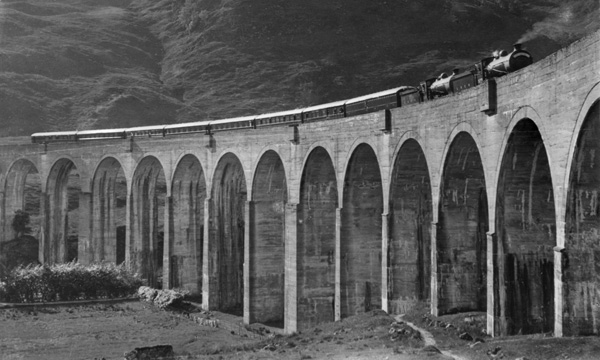
When the "Northern Belle" started running in 1933 an all-stel BG was used as a "baggage car" and it can be seen in this view from 1934 as part of the day portion crossing Glenfinnan Viaduct behind two ex-NBR D34s with No 9221 Glen Orchy leading. Photo: Photomatic.
BG, FSal, TK, FO, FO, RK, SLT, BFK
For further details see "The Northern Belle" (link below).
Click on the image for an enlargement

A marvellous picture of an unidentified ECML Up express accelerating away from York in the early to mid 1930s behind 4472 Flying Scotsman. A full set of destination boards is being carried, including the all-steel BG behind the tender. The light suggests an early morning express from Newcastle.
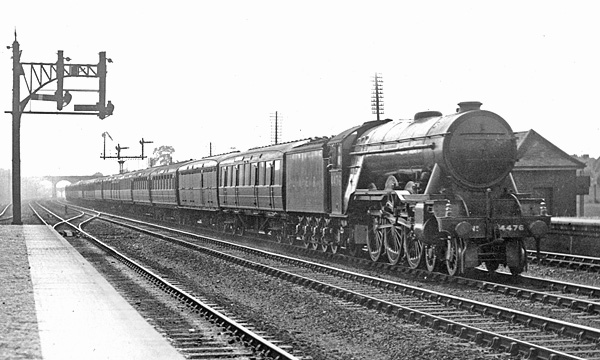
Midday trains have always been hard to capture at Welwyn Garden City and this picture of A1 No 4476 Royal Lancer with an all-steel BG prominently in second place has defied complete analysis. Judging by the condition of the loco the date has been revised to between June 1935 and June 1937 (with thanks to John Smart). appears to be the mid- to late-1930s and the train with its 15 carriages may be the Saturdays Only 1.5pm King's Cross-Edinburgh/Newcastle with a portion for the Tyne Commission Quay attached. The identifiable head of the train is:
TK 3rd
BG bogie van (all steel)
TK 3rd (ev)
TK 3rd (ev)
RTS restaurant triplet set
FK 1st
...remainder unclear.
I have used "ev" to indicate modern, end-vestibule carriages. The importance of the train can be judged by extensive provision of roof destination boards.
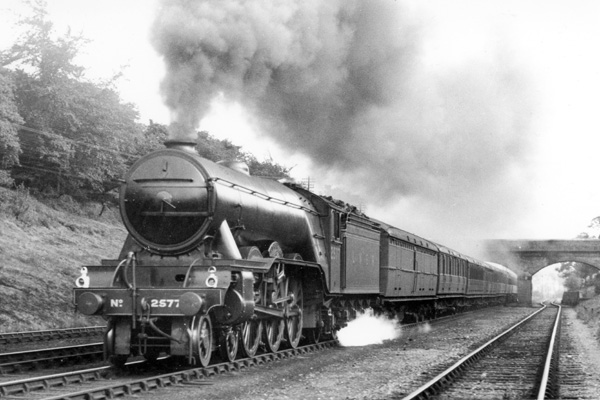
Small wonder that Greenwood was such a popular location, especially on a cloudy day - although the need to get a decent shutter speed could lead to a narrow depth of field, which in this case only reaches as far as the second carriage in the train, a down express.
It's July 1932 and the all-steel BG behind the loco is looking quite grimy, doubtless through being frequently so close to the loco, in this case, A1 No 2577 White Hawk. The next view is an enlargement. Photo: Photomatic.

The all-steel BG is clear to see, what about the rest of the train, the far end of which is concealed by the bridge? My estimate is based on what appears to be a 3-coach through portion at the head of the train, like the ones used in West Riding expresses:
BG bogie van (all steel)
TK 3rd
TK 3rd
BCK 1st/3rd brake
...remainder unclear.
This appears to be the King's Cross 1.30pm with the Hull portion at the head. The van would have travelled through, or been taken off at Doncaster - by the train loco for at this time, Pacifics to Leeds were barred. Once the Hull portion was away, a smaller loco from Copley Hill would back on and take the train to Leeds Central.
To readers of "LNER Passenger Trains and Formations, The Principal Services" who felt that coaches described in the captions could not always be made out, I feel the same way and a big reason lies in the printing process and "screening" in order to produce a matrix of tiny dots of ink, and which cannot help but reduce clarity of fine detail. It's the printing world's equivalent of pixellation.
The second reason is that in many pictures in order to identify carriages in a photograph that are blurry to start with, requires the ability to recognise a train by its formation, and then compare its blurry outlines with what was rostered in such a service, and of course, recognise the actual carriages, which were often not as rostered. This is quite a good example of what can be done with magnification of an original print.

At Potters bar, date unknown in the 1930s, recently built A3 No 2596 Manna has a late afternoon or early evening Up ECML express with a full set of nameboards, including the D.45 all-steel BG behind the tender. Beyond it is a full 1st, then a restaurant triplet set. Photo: Author's collection.
Click on the image for an enlargement

One of the more interesting pictures taken on Saturday, 31st March 1934 near Hadley Wood with K2 No 4683 approaching King's Cross with an Ordinary Passenger train; having emerged from Hadley Wood South tunnel, it's passing Greenwood signal box which has turned the train onto the slow line.
The passenger carriages are Howlden 6-wheelers and, beyond them, are several ex-GNR vans. This, the main body of the train, is a typical GN Section working with vans on the GNML by attachment to the rear. The most striking part is the ECJS D.45 all-steel van attached to the head of the train - what a contrast this recently shopped modern van of 1927-28 makes with the rest of the train, which dates back to the 1880s. Photo: author's collection.
Click on the image for an enlargement
The photo was taken during the winter timetable and the closest Carriage Working that I can find is from the summer of that year, for the 7am Leeds-King's Cross which took five and a half hours to reach its destination and was rostered for two ex-6w twins and a bogie van on the rear from Leeds Central. At Doncaster, the ECJS BG (being worked back from Aberdeen) was added to the front as a fresh loco took over. More GN vans were added to the rear en route to King's Cross, at Newark, Grantham and Peterborough, and one detached:
BG |
ECJS all-steel |
Aberdeen |
------------------------------------------------------------------
twin compo brake |
ex-Howlden 6w |
Leeds |
twin compo brake |
ex-Howlden 6w |
|
BG |
ex-GNR 56'6" |
|
------------------------------------------------------------------
BV |
ex-GNR 51'1 1/2" |
Lincoln |
|
B (6w) |
ex-GNR |
Grantham |
|
B (6w) |
ex-GNR |
M&GN |
to Finsbury Park |
The all-steel BG had travelled north in the previous night's 7.40pm "Aberdonian" from King's Cross and was being returned overnight by various trains, this attachment to the Ordinary Passenger from Leeds being its final leg.
Note, by the way, how beautifully the simulated teak has been rendered with contrasting "panels", the end panel which carried the numbers was usually darker and is seen really well. It's a point I make in the topic about LNER teak (there's a link below), and wish I had known earlier!

It's high summer in 1936 and A3 No 2508 Brown Jack is near Potters Bar with the Up "Flying Scotsman". This being the south end of the train, the BG can be seen, an all-steel BG to D.45 as usual with destination boards. Photo: LCGB.
Click on the image for an enlargement

A4 2509 Silver Link heads south in 1938 with an up express and a steel BG as part of the roster. It looks like No 172 (b.1928) and still less that ten years old. In his final book (1998), Michael Harris asserted that these vans "remained in top link service until at least 1937" which understates the position, for the first vans to be relegated.from the ECJS fleet were the oldest, the post-Grouping designs beginning with teak-panelled D.43 from 1924. The ECML rosters for summer 1939 had many all-steel vans still in top flight service; it does seem to be a neglected design!
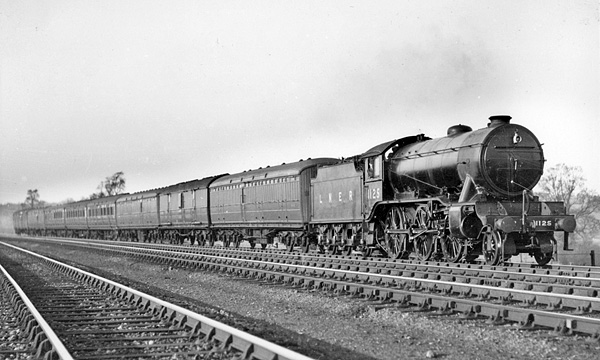
One of my favourite pictures has K3 No 1125 at Brookmans Park in 1938 on a secondary gangwayed train between Leeds/Doncaster and King's Cross conveying through vans. All bar one here were LNER-built BG types for the ECJS and GN Section fleets, the exception being an ex-GNR Gresley 51'1 1/2" BV with plug doors:
D.43 teak panelled
ex-GNR BV
D.45 all-steel
---------------- passenger formation (CK,TK,BTK?)
D.198 steel-panelled
????? another teak-panelled BG?
Note that the steel-panelled van is the only one on steel-angle trussing and Gresley 8ft bogies.

This time it's K3 No 228 in charge of the same train, at Ganwick, and all the visible bogie vans are modern. Indeed, the leading trio offers a good comparison between the all-steel vans of 1927 and the later '30s steel-panelled ones:
D.45 all-steel
D.45 all-steel
D.45 all-steel
---------------- passenger formation (CK,TK,BTK?)
... trailing vans not clear....
It's also a pretty fine view of a powerful mixed-traffic loco that modellers may not choose for such a working. Modernisation by gangwayed carriages would have taken place relatively recently, but mainly with cascaded pre-Grouping carriages, apparently 2/3 ex-GNR. So you get the irony in this case of an "old" passenger train conveying "new" vans. Many modellers think that parcels trains were the norm on the LNER but south of York there was only one up and own parcels train a day running overnight: most vans in ECJS and GN circuits were conveyed by passenger train.

An example of a GN Section express being used to convey through vans, A4 2512 Silver Fox has a King's Cross-Leeds train based on a "steel quintuple set". The second van behind the tender is an ECJS D.45 all-steel BG on its way north.
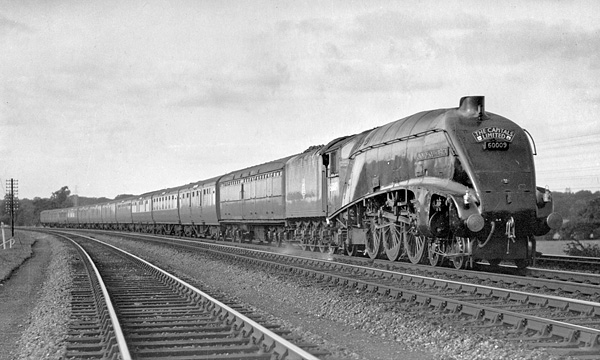
A striking view of the "Capitals Limited" as it heads south at Marshmoor on 8th September 1951 with the last non-stop of the summer season behind 60009 Union of South Africa. The set originally built by Thompson for the "Flying Scotsman" with fairing over the solebars can be seen, but the Thompson BG is not present: it has been substituted by a Gresley D.45 all-steel one. The bodywork is in sparkling condition and it's a pity that the number cannot quite be read!

A fine picture from the 1950s shows A1 60114 W.P.Allen at Holloway with a north-bound express, the visible passenger carriages being Thompson and BR Mk.1. The all-steel BG, now in all-over crimson, looks to be in fine condition.
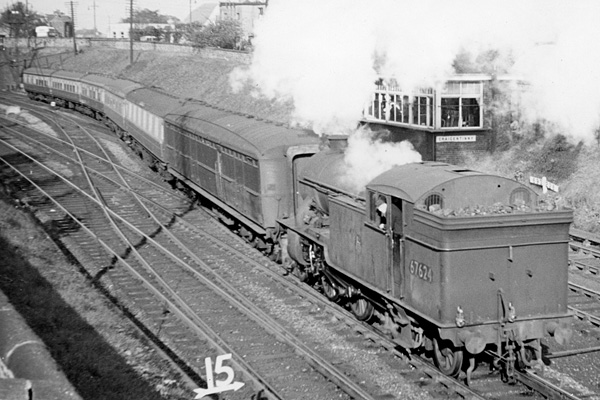
V3 2-6-2T No 67624 with an empty train at Craigentinny in 1956, a mixture of BR Mk.1 and Gresley stock. The D.45 BG displays the radiussed ends and the plating on the roof quite well.

Still going strong in 1958, B1 No 61078 is at Banbury General on 12th July with a cross-country express at the head of which is a Gresley all-steel BG to D.45, Next to it is a Thompson steel-panelled version.
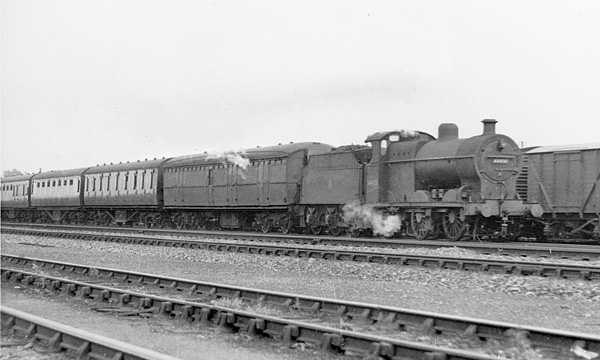
And finally for now, a view of an all-steel BG that is definitely no longer in ECJS front line service! On a poor day in the 1950s at an unknown location, 4F No 44408 has an LMR Ordinary Passenger train made up with Stanier secondary carriages, and a D.45 van behind the tender.
D.113 teak panelled modelling notes/pictures are here.
D.45 modelling notes/pictures are here.
LNER teak coaches and livery is here.
Related NPCS:
ECJS and GNR clerestory BG: is here.
56'6" ECJS and GNR BG: is here.
Gresley 56'6" BG to D.44: is here.
Gresley 61'6" steel-panelled BG: is here.


